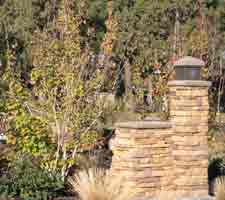Benefits of Native Landscaping
Self-Containing Ecosystem
EPA530-F-05-015
August 2005

The landscape at the Century Park retail complex in central Oregon never needs fertilizer, pesticides, extensive watering, or mowing, thanks to the native landscaping installed by WinterCreek Restoration. Fifty-one native species—those that have evolved and adapted to the geography, hydrology, and climate of the region—occupy the 33,000-square foot landscape to create a self-sustaining ecosystem. “The project is so successful,” commented landscaper Rick Martinson of WinterCreek Restoration, “it’s almost working too well.”
The success of the project is primarily due to the native plants used throughout the landscape. The goal of native landscaping is to create a plant “community.” In a natural system, each plant occupies a specific niche. The diversity of the native landscape preserves naturally occurring genetic material and provides better resistance to disease. Furthermore, plants native to a specific region tend to be more robust because they have adapted to the local soil, conditions, and weather patterns.
To preserve the native species, Martinson and his team surveyed the property prior to excavation to identify plants and trees to save. Trees to keep were fenced off, and more than 300 plants were collected and transported to the WinterCreek Restoration nursery. A quick collection and transportation process allowed the majority of plants to survive the move to the nursery and back again.
Designing a drainage and irrigation system to minimize water usage was a key factor in the project’s success. Martinson incorporated rainwater and storm runoff into the landscape and supplemented the irrigation with an in-ground drip system. Runoff from the parking lot is captured in tree wells, and a roof collection system diverts runoff to a stream bed below, which is used to irrigate plants. Storm drains also provide supplemental irrigation, and in some spots, provide the only irrigation to the landscape.
The water bill for Century Park is usually $10.75 per month—the minimum monthly water bill imposed on commercial sites—and significantly less than the average $2,400 monthly water bill found at similar landscape projects. But irrigation is just one of several costs that are lower than projects using traditional landscaping methods. Maintenance costs are 80 percent to 90 percent lower than average commercial landscapes, and are even less than a typical residential property in the area. With the integrated irrigation system, the project’s total installation cost was 25 percent lower than other similar projects.
Despite the environmental and financial benefits to native landscaping, there are still obstacles to overcome. Educating the public about native species is foremost; people incorrectly assume that native species are not decorative enough and limit plant choice too severely. Developers must also be educated about native landscaping. Too often, landscape is an afterthought, and native landscaping needs to be considered at the start and throughout the entire project to work properly. Finally, owners and developers need to understand that property cannot be leveled if plants are to be saved. Even with these challenges, Martinson sees native landscaping becoming more mainstream and hopes to see it as the standard landscape in the commercial sector.
For more information, please contact Rick Martinson at 541 948-0661 or e-mail WinterFarmsInc@aol.com (winterfarmsinc@aol.com).
View and print this fact sheet (PDF) (2 pp, 120K, about PDF)
Disclaimer: Reference herein to any specific commercial products, process, or service by trade name, trademark, manufacturer, or otherwise, does not necessarily constitute or imply its endorsement, recommendation, or favoring by the United States Government. The views and opinions of authors expressed herein do not necessarily state or reflect those of the United States Government, and shall not be used for advertising or product endorsement purposes.
![[logo] US EPA](../gif/logo_epaseal.gif)